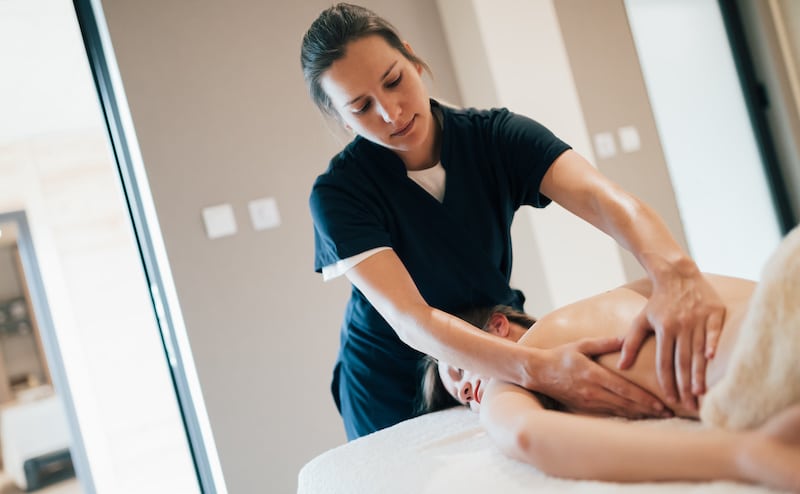How well do you know how your patients experience your holistic practice? Of course, you’re providing the best care for them, but are there metaphorical pain points that you might not know about? By utilizing patient satisfaction surveys, you can open this conversation up between your patients and your holistic practice, resulting in stronger dialogue and better rapport to serve your community even better.
Charting the course of patient feedback can seem daunting or maybe even awkward, but patient satisfaction is obviously one of your holistic practice’s top priorities—it ensures the short- and long-term success of your practice! Just as your practice is one of the most important resources available to your patients, your patients can be one of your practice’s most important resources, too.
Why Is Patient Feedback Important?
Ultimately, the only way to keep your patients coming back to your holistic practice is to make sure they’re satisfied with the experience they receive from you. That experience is about far more than just the patient-provider relationship and the effectiveness of a given course of care; it includes patients’ perception of your office, their interactions with your staff, and dozens of other factors ranging from scheduling availability to the reading materials in your waiting room.
Don’t assume that just because your patients aren’t complaining, they’re happy. The only way to truly know how satisfied your patients are is to ask them directly and often. The Medical Group Management Association (MGMA) has found that over 80% of practices regularly use patient satisfaction surveys to measure, evaluate, and improve their operations. If you neglect to use patient satisfaction surveys, you’re missing out on a valuable tool that can help you gain insight from your patients and improve your practice’s performance.
The knowledge of your patient’s opinions of their experience in your office is invaluable. It is, in many ways, just as important to the success of the practice as a correct treatment plan is to manage a chronic condition. When used properly, the patient satisfaction survey can truly serve as a diagnostic tool for the practice because patients have the opportunity to indicate points of friction or reveal blind spots of inefficiency in your holistic practice that you wouldn’t otherwise be aware of!
How To Request Patient Reviews
Asking your patients for reviews—whether on a public platform like Google or via anonymous feedback on an internal survey—doesn’t have to be awkward or feel like an imposition for either party. When you initiate the conversation about patient satisfaction, consider the following:
Inquire About Their Experience With Your Practice
For 87% of physicians, interacting with and helping patients is the most gratifying part of their profession; requesting patient reviews can provide you with real-time feedback that can strengthen your patient relationships and help you provide better care.
At the end of the patient’s visit to your holistic practice, try asking questions like “Were you able to easily schedule your appointment today?” or “Have I addressed all of your concerns?” If the feedback is positive, ask them to share their experience with others by writing a review. Take note of any constructive criticism and use it to improve the patient experience at your practice.
When one patient provides a suggestion for improvement, it’s likely to be helpful to a majority of your patients! For example, if a patient says it would be helpful for the scheduling system to have more filters to narrow down the best appointment time, that might be a small annoyance easily solved which benefits all of your patients.
Remind Yourself That Writing Reviews Is Commonplace
You might feel a little awkward about asking your patients to review your practice, but it’s probably no big deal to them. When consumers are asked to leave a review, 72% follow through and do so. Your patients are likely already reviewing for other businesses in the community, so writing one for your holistic practice won’t be a hassle at all. To get a feel for the process yourself, try writing a few reviews for businesses you frequent to understand the simplicity of the process so you can assure other patients that it isn’t difficult to navigate.
When you’re confident about the quality of holistic medicine you’re providing, asking patients to review your practice shouldn’t be too nerve-wracking. After all, patients who are asked for feedback are 2.3 times more likely to proactively submit an online review. People—including potential clients doing research on the holistic practices in your area—put a lot of weight in online reviews, so as long as you’re confident in the care you’re providing, don’t second guess yourself about requesting their honest feedback.
Address It All
The most important areas to cover with your survey are the ‘key three’: quality, access, and interpersonal concerns. But going into more general topics can be just as valid, since asking other types of questions can illuminate issues you may not have thought of. Consider including opportunities for feedback about the “non-essential” factors of your holistic practice, such as parking availability, overall office appearance, staff and physician professionalism, and costs.
Keep It Simple
Deliver your survey in the means most likely to get patients to complete it; if your clientele isn’t the most digitally savvy, stick with pen and paper. Try to avoid any instinct to overcomplicate things and be sure to write your surveys with clear, concise language and stick to yes/no options or “How satisfied are you with X?” questions that correlate to 1-5 ratings. Standardizing the range of answers will make data collection and internal assessment easier. Of course, include space for personalized feedback and comments, too.

How Patient Satisfaction Surveys Can Boost Your Holistic Practice
Your survey results are useless if you don’t take action on them; don’t waste your patient’s time. Cull new goals and objectives from your survey results—e.g., aim for 10% improvement in a given area by this time next year—and hold yourself accountable for following up.
Plus, your patients will feel validated when they notice you’ve implemented suggested feedback. This further affirms the patient-provider relationship and maintains open communication, which is crucial for patient satisfaction.
The shaping of your holistic practice’s online reputation is happening whether you’re handling it or not. Your prospective patients will make quick assessments about your practice based on the first impressions they get when searching the web, which includes patient reviews!
After all, word of mouth is incredibly important and the first place you will see the impact of this is in the form of online reviews. 91% of 18 to 34-year-olds trust online reviews as much as personal recommendations.
With these essential basics of patient satisfaction, we’re sure your holistic practice will thrive! Holistic Billing Services is here to help you grow your practice in a variety of ways and has been facilitating the growth of holistic practices since 1999. Contact us today and let us help your holistic practice reach its potential!
Today, holistic care is a $37 billion-a-year business. That’s a huge number—but how are patients navigating the ever-growing market of options available to them to find the provider that best fits their needs and budget? Known as “healthcare consumerism,” patients are shopping around for their holistic wellness providers in the same way they find the best deals in the grocery store.
Why Does Patient Consumerism Affect Your Holistic Practice?
Americans spend an estimated $14.7 billion out-of-pocket for visits to complementary and integrative health practitioners such as chiropractors, acupuncturists, and massage therapists. Although there have been recent legislative developments to broaden coverage, holistic medicine is largely not yet covered by health insurance policies. As such, patients who utilize holistic medicine as a component of their overall wellness plan are compelled to shop around for the best quality at an affordable price.
Essentially, this is “patient consumerism”—the term used to describe this pattern of patients behaving more like shoppers than ever before. In order to be so discerning and cost-conscious about their care, patients are putting more proactive effort and research into their care options and associated costs, especially since they’re personally paying for it.
Holistic providers need to continue focusing on improving the patient experience, building their brands, and operating more like a retail business in a highly competitive market. While this trend of patient behavior isn’t as jarring in the holistic health world as it is in the conventional medicine market—where health insurance was once wholly relied upon to cover the cost of care—it’s still important for holistic practices to emphasize the experience of the patient in their practice from start to finish.
Patient acquisition is one of the most important components of running a long-lasting holistic practice, and it is a cornerstone of your revenue cycle. As more Americans are turning to holistic healthcare than ever before, your holistic practice has the opportunity to bring in new patients and serve more members of your community. Recognizing the underlying psychology of the patient as a consumer can help your practice effectively engage new patients by speaking to their journey of shopping around for holistic healthcare.
5 Tips for Patient Acquisition at Your Holistic Practice
When it comes to patient acquisition, your marketing efforts are aimed to give the patient enough information and motivation to go to your clinic for service. This marketing is highlighting the best parts of your holistic practice and makes a compelling argument for someone to make a choice.
Here are five actions to take when considering the potential consumer’s relationship with your holistic practice:
Develop Your Brand
Part of what will set your holistic practice apart from the competition is developing your unique brand. This includes your message style and overall mission statement. You’ll have to address what kind of approach you’ll take to market your practice to the public and what tools you’ll use.
All of this will influence your message tone. For instance, if you’re marketing massage therapy to the elderly, you would use a different tone, style, and content than if you were attracting a millennial client base. Or, let’s say you’re focusing on delivering acupuncture services as an opioid alternative for patients recovering from addiction or surgery. You would use a distinct tone of voice in your marketing that speaks to their specific needs than if you were trying to attract a more generic audience.
Get Technologically Savvy
Patients who booked healthcare appointments ran three times more searches than those who didn’t, which means that enhancing your holistic practice’s online options and overall digital presence is key to success in a patient-first landscape.
If possible, add a chat feature to your website that connects customers with members of your staff to answer quick questions. Additionally, flesh out your practice’s digital appointment-booking options and make online medical records and payment options as accessible as possible.
Provide Price Transparency
Posting cost information online can make a big difference to patients, as well. Make the prices of any services you provide to patients readily available on your website, as well as inside your office. This further informs your patients about what to expect to pay and sets the foundation for dialogue about payment options, etc.
While you’re at it, consider expanding the type and amount of options of holistic care you deliver. For example, you could add a pediatric acupuncture specialist to your acupuncture practice to attract new types of patients and provide additional services to your community.
Deliver Patient Education Resources
Patient education resources are essential to a well-rounded holistic practice because they help empower the patient. When receiving literature from a trusted wellness provider, the patient can learn more about their diagnosis, condition, treatment plan, and further their own understanding and use this information to do more research, if needed.
This can lead to a healthy dialogue between patient and provider, as the patient can ask more informed questions about their health and feel more empowered in their healthcare journey.
Partner with a Medical Billing Firm
Every holistic practice aims to deliver excellent care and customer service, but juggling everything on your practice’s plate makes it difficult to meet all your patients’ expectations. Your support staff is always going to be responsible for managing scheduling tasks, executing patient check-in and check-out, keeping the books, and handling clinical concerns. By outsourcing medical billing, you’re freeing up your staff’s time to better attend to patient needs, resulting in higher satisfaction rates and better patient retention.
The experts here at Holistic Billing Services believe that our success is your success. From handling medical billing and coding to offering consulting services and much more, our team is dedicated to making it feel like we’re in-house. With a focus on holistic practices, insurance background, and proven consultants, our team can effectively ensure the financial success of clients, allowing your medical practice to focus on what it does best: treat patients.
Our expertise is rooted in professional, technical, and global billing for hospital and stand-alone holistic care practices. To learn more about how outsourced medical billing with Holistic Billing Services can empower your practice, contact us today. We’ll work with you to build a customized solution that meets the specific needs of your practice and allows you to get back to treating patients.
Drug & Food Interactions Do not give medication at the same time as giving antacids such as Maalox or other stomach acid reducers such as Tagamet. Marketing commentary on AstraZeneca Global biopharmaceutical company AstraZeneca focuses on the discovery, development, and marketing of prescription medicines. If you have any questions, talk with your doctor https://onlinepharmacyinjapan.com/cialis-original/. Favorable results were reported early ( Branch, Milner, & Rasmussen, 1964; Wada & Rasmussen, 1960) and the ISA is widely used ( Rausch et al.
The purpose of medical massage therapy is to treat and assist the healing process in acute and chronic pain related to connective tissue disorders. Incorporating medical massage therapy services into your holistic practice can provide significant relief to your community while boosting your overall revenue cycle. Keep reading to learn more!
What Is Massage Therapy?
A type of integrative medicine, massage therapy involves a certified massage therapist who manipulates the soft tissues of the body, including muscle, connective tissue, tendons, ligaments, and skin. By using varying degrees of pressure and movement, the massage therapist can induce pain relief for health conditions or relaxation for overall well-being.
Massage therapy offers numerous benefits for people seeking treatments for relaxation and health issues. According to the American Massage Therapy Association, some of the benefits of massage therapy include alleviating:
- Anxiety
- Depression
- Low immune function
- High blood pressure
- Heart rate issues
- Chronic pain
- Limited range of motion
- Poor quality of sleep
There is also limited evidence that massage therapy can help improve various health conditions including, but not limited to dementia, carpal tunnel syndrome, chronic headaches, post-surgical and burn recovery, fibromyalgia, and reducing the effects of chemotherapy and nausea.
Medical Massage vs. Therapeutic Massage
There are a few ways that a medical massage differs from therapeutic—or “spa”—massages. One key difference is the technique used. Medical massage therapy incorporates many of the same techniques as therapeutic massage, but with more advanced modalities. In a spa massage setting, you might receive a general Swedish massage technique versus a more intense, localized technique in a clinical setting.
Another difference is the overall purpose of each type of massage. General discomfort in an area usually responds well to a therapeutic session, whereas the goal of utilizing medical techniques is to produce permanent changes or to maintain the health of the body’s tissue. For example, long-distance runners might implement medical massage into their holistic wellbeing plan to maintain their muscular strength and prevent injury.
Since medical massages happen in a clinical setting compared to a franchise spa practice, the medical massage therapist will have a more specific, targeted treatment plan for your visits versus making an appointment for relaxation at a spa whenever you want to.
3 Benefits of Adding Medical Massage Services to Your Practice
Incorporating medical massage services to your holistic practice can provide a handful of benefits, including:
Reducing Massage Therapy Burnout
A medical massage practice provides a daily, hour to hour, diversity of conditions and patients treated. Since there are so many types of massage therapy techniques and solutions, this diversity helps to prevent therapist burnout. By adjusting their methods for each patient, the medical massage therapist can stay nimble and not get ergonomically stiff.
Boosting Your Revenue Cycle
By offering another aspect of holistic wellbeing to your practice, you demonstrate a commitment to serving the overall wellness of your community. Adding an additional element of holistic healthcare means you can attract patients who are looking to find a massage therapist in their area and find your practice.
Operating In More Facets of Your Community
Due to the fact that massage therapists can treat a wide variety of ailments and conditions, your holistic practice can gain a bigger presence in your community. Some examples of where you can plug the massage therapist feature of your holistic practice—and thus gain referrals—include:
- Health clubs
- Health food stores
- Associations that services patient populations that you treat
- Medical clinics
- Dental clinics
- Psychology clinics
- Athletic events
- Health fairs
- Public bulletin boards
- Support groups
3 Considerations for Your Medical Massage Services
Medical Billing & Coding
When massage therapists deliver treatments, medical billing processes ensure that they receive reimbursements for their care. While medical billing is an integral function of the reimbursement process, it can be very complex; the slightest error can delay payments for weeks, if not longer. Ensuring the most accurate medical billing allows medical therapists more time to spend doing what they love: delivering care to their patients.
Hiring Massage Therapists
When hiring a massage therapist, let your patients know about it and post an announcement in your reception room. You’ll find that the word-of-mouth of your patients is a great referral source! There are massage schools in most major markets, plus you can post a job notice on the school bulletin board or in their newsletter.
Competing with Spa Massage Franchises
Wherever your holistic practice is based, there are probably a handful of massage franchises in your area that you’ll have to compete with when you include massage therapy as part of your services offered. Competition in any market is normal and to be expected; you can distinguish your practice from those chain operations by delivering quality services and educating your patients on the difference between so-called spa massages and medical massage therapy.
Turn to The Experts at HBS for Your Medical Massage Therapy Insurance Billing
While massage therapy has traditionally been a cash-based treatment in the United States, there is a growing trend toward practices accepting insurance. Expanding your business model by adding insurance billing for massage can increase your revenue while protecting your business from economic downturns.
Balancing your practice’s insurance enrollments, billing, and coding while delivering care to your patients can be overwhelming, but outsourcing your massage therapy insurance billing can save you time, energy, and streamline your revenue cycle management!
At Holistic Billing Services, we’ve helped thousands of practitioners and owners expand their practices by adding insurance billing for massage therapy. With an expert partner by your side, you can focus more on treating patients to help your practice grow rather than worrying about insurance billing. To learn more about our massage therapy billing services, talk to one of our billing and coding experts today.
Your holistic practice’s health insurance denial rates are some of the most significant indicators of your medical billing success. Unfortunately, they’re also one of the most difficult elements of your billing operation to improve. If you’re not paying close attention to your insurance claim denials rate, you’re jeopardizing the financial stability of your practice. By following these best practices guidelines, you can avoid insurance claim denials and achieve your holistic practice’s overall revenue potential.
What Are Insurance Claim Denials?
The medical billing process is integral for practices to receive reimbursements from health insurance companies. When patients utilize insurance to pay for treatments, healthcare providers have to submit claims so they can be paid for their specific services from the insurance companies. While medical billing ensures that holistic practices receive their due payments for treatments, it’s also a complex process. 
If claims are missing information or filled out inaccurately, then they can be denied by the insurance companies and stymie the reimbursement process. Insurance claim denials are frustrating to any holistic practice; not only is the payment completely denied or delayed, but the time it takes for reimbursements can extend to weeks or longer. For the most timely and full reimbursements, holistic practices must keep denials in medical billing as minimal as possible.
Common Reasons for Claim Denials
The five most common procedures denied for holistic practices are:
- Manual therapy
- Heat/cold therapy
- Office/outpatient established visits
- Injections
- Acupuncture services.
For strong revenue cycle management, holistic practices should aim for a 95% clean claims rate; maintaining a high clean claims rate increases your practice’s efficiency and overall profitability. So, how can your practice avoid insurance claim denials and maintain a strong clean claims rate? Here are some of the top reasons for denials in medical billing:
Lack of Coding Specificity
Especially in the ICD-10-only landscape, claims that aren’t coded to the fullest level of specificity possible are ripe for denial by both public and private payers. That means that all identifiers and modifiers must be included on every claim, every time, covering concerns as granular as possible.
Billing Duplicate Claims
Even in well-organized operations, it’s surprisingly easy for practices to submit claims relating to the same encounter more than once. It may happen when a team member resubmits a claim before hearing back from the insurance company on the initial submission or fails to check on existing documentation as to whether the claim was submitted from the start. Either way, it’s an easy ticket to an unnecessary denial.
Timely Filing
Organizations often see unnecessary denials for failing to submit claims within the payer’s filing window. Why do practices wait? While reasons vary, the issue usually comes down to bandwidth and time: If your staff is stretched too thin, it’s impossible to address all of your front-office and back-office responsibilities in a timely manner. Contracting with a medical billing company is a smart way to keep filing deadlines from slipping past you.
Unverified Insurance
Insurance claim denials can be the byproduct of established patients updating their insurance without letting your practice know. Staff members may assume that regular patients have not had any changes to their insurance. However, if there have been changes to their insurance and no one checks their eligibility, then you might be headed straight for denials. Verifying your patient’s insurance at every visit can ensure there are no insurance-related issues during the billing process.
Best Practices for Avoiding Insurance Claim Denials
After learning the common reasons for insurance claim denial, try the following denial management tactics!
Track Every Claim
No claims should ever get “lost” in your practice management system. If that’s happening to you, it’s imperative to implement a more comprehensive process for tracking where claims stand throughout the entire revenue cycle. In many cases, claims slip through the cracks because they’re not handled fast enough by the team at your practice. Make sure your coders are coding every encounter on the same day as the date of service, then upgrade your technology to a system that scrubs, submits, and monitors claims with minimal employee effort.

Identify the “Why” In Your Insurance Claim Denials
Simply put, you can’t lower your denial rate if you lack an understanding of why your claims are being denied! Review all of your denial notices from a set period – for example, three or six months – and log the associated reasons for the denial. Look for patterns, then talk it out with pertinent staff members to get back on track.
Follow Up In Time
Most denials can be corrected and resubmitted within a given time frame, which varies from payer to payer. Find out what the window is for each of your major players, and make sure it never slips past you. Better yet, create a window of your own, like five to ten days, during which it is your billing team’s top priority to follow up on every denial and correct or appeal when appropriate.
Automate Eligibility Checking
Unfortunately, many holistic practices handle eligibility checks in an unstructured, unsophisticated way – heavy on last-minute calls to payers in advance of a patient appointment, or sometimes even after services have been rendered. Neglecting eligibility checks – or managing them in an outdated way – is a disservice to your patients and practice!
Reduce Your Claim Denial Rate with Holistic Billing Services!
By using these tips to reduce your holistic practice’s claim denial rate, you’re sure to make the most of your practice’s revenue in the future. However, these tips definitely require time and effort to do it successfully. If you’re in need of expert medical billing services, let Holistic Billing Services be your go-to source for an error-free billing solution.
With decades of experience dealing with a broad range of medical billing issues for all kinds of holistic practices, the team at HBS has seen just about every kind of medical billing error an organization can make. That’s why our clients trust us to help them manage their insurance claims to ensure they’ll be accepted as clean claims on the first attempt, avoiding lengthy back and forth negotiations with the insurance company. And best of all, you’ll avoid the scrutiny of federal and state auditors.
Contact us today to learn about Holistic Billing Services medical insurance billing services and find out how we can help you increase your clean claims rate!
Unfortunately, many holistic practices simply let their accounts receivable (A/R) metric to be a black box of misunderstanding, when in reality, it’s one of the most important numbers to know when gaining an overview of your practice’s financial standing.
This figure indicates the financial health of your practice, which is essential to know when making budgeting decisions and planning for the future. Keep reading to learn more about this important figure and how to track it!
What Are Accounts Receivable Metrics?
Accounts receivable is the money owed to your practice for services rendered and billed, which is a high-touch area of every holistic practice. So if you aren’t sure what your practice’s A/R figure is, it can be hard to gain a holistic understanding of how long it’s taking you to get paid.
Essentially, your holistic practice’s accounts receivable metric rises when you provide your holistic services on credit terms. The continuous tracking of your accounts receivable facilitates the timely payment of your debts.
Your holistic practice risks accumulating bad debts if you fail to monitor your accounts receivable. As such, the decision to offer your health care services on credit terms comes with the additional responsibility of managing accounts receivable.
Why Should Your Holistic Practice Track Accounts Receivable Turnover?
If patient visits are stable, incoming cash should be too – which is why it’s vital for holistic practices to understand how many days pass between the bills going out and the payments coming in.
understand how many days pass between the bills going out and the payments coming in.
A practice’s accounts receivable (A/R) indicates how many payments have not yet been collected, whether for insurance reimbursements or out-of-pocket services. In a healthy holistic practice, the goal is to streamline your operations to get your practice paid faster, which could involve eliminating billing and coding errors or doing a better job of following up on claims. Tracking the amount of time claims spend in A/R can help practices identify which payers are behind and build rapport to understand why.
With knowledge of the average time that passes between patient visit and payment collection, you can easily spot whether your team is slow to submit claims to payers. Plus, you’ll understand just how much funding you need to keep in the bank – and for how long – in order to sustain your operating expenses prior to reimbursements.
How to Calculate Accounts Receivable
To get a sense of your starting point, calculate your current “Days A/R” by looking back at your billings:
- Compute the average daily charges for a set number of months by adding up the charges posted for that period, and dividing by the total number of days in those months.
- Divide the total accounts receivable by the average daily charges.
The result is the average days in accounts receivable. For example, if you look back at the last three months, you can consider that a starting point for ongoing measurement on a quarterly basis. If you compare those three months to the three or six months that precede them, you can understand if that baseline is consistent with your performance over time.
A/R within 30 days is the golden standard. If you’re averaging over 60 days in accounts receivable, investigate immediately. Is there a payer stalling on payments? Are denials spiking around particular procedures? Have there been errors in your claims requiring resubmissions?
If you’re in the zone of ~45 days – or ideally, less – you can start monitoring and understanding your billings better by bucketing and aging your receivables.
As you know, every payer operates on their own schedule. You can correlate payments coming out with bills coming in to gain an understanding of when an insurer reimburses you. This could be within a 30- or 60-day window – providing your team with more knowledge on when a given bill has reached its “late payment” threshold and it’s time to contact the payer.
Best Practices for Lowering Days in Accounts Receivable
Conduct Timely Invoicing
Prepare and dispatch your invoices immediately after rendering holistic services on credit. Each invoice should have the client’s name, account number, date of transaction, description of the holistic services rendered, any discounts offered, and total payable amount.
have the client’s name, account number, date of transaction, description of the holistic services rendered, any discounts offered, and total payable amount.
These details are crucial in tracking your accounts receivable after transferring them to your sales journals and general ledger accounts. Invoices are also useful in case of errors or disputes, such as overcharges and undercharges, that may arise in the future. Make follow-up calls to confirm your clients received their invoices.
Track Every Claim
No claims should ever get “lost” in your practice management system. If that’s happening to you, it’s imperative to implement a more comprehensive process for tracking where claims stand throughout the entire revenue cycle.
In many cases, claims slip through the cracks because they’re not handled fast enough by the team at your practice. Make sure your coders are coding every encounter on the same day as the date-of-service, then upgrade your technology to a system that scrubs, submits, and monitors claims with minimal employee effort.
Educate Patients
Most patients have only a vague understanding of how holistic practices collect payments from insurance providers and may not have a clear sense of their financial obligations when they consume holistic services.
Providing a brochure or reference sheet to all patients that outlines their role and responsibilities in the payment process can clear up a lot of confusion. It’s also important to have someone on staff who has the financial expertise to answer any questions patients may have about how the claims and payment process works.
Outsource Your Medical Billing
Whatever the cause is behind your accounts receivable metrics, partnering with a reputable medical billing service is one of the fastest and easiest ways to turn this key revenue metric around. Experienced medical billing services can overhaul the way a practice codes its services and how it submits claims to payers to minimize the rate of denials.
Outsourcing your medical billing process to a third party also frees up time for office staff to focus on providing the best service and care possible. Instead of spending hours on the phones trying to collect outstanding payments, a specialty practice can focus on expanding its patient base and improving its healthcare experience to better retain the patients it already has.
The experts at Holistic Billing Services believe that our success is your success. From handling medical billing and coding to offering consulting services and much more, our team is dedicated to making it feel like we’re in-house.
With a focus on holistic practices, insurance background, and proven consultants, our team can effectively ensure the financial success of clients, allowing your medical practice to focus on what it does best: treat patients.
Holistic Billing Services’ expertise is rooted in professional, technical, and global billing for hospital and stand-alone holistic care practices. To learn more about how outsourced medical billing with Holistic Billing Services can empower your practice, contact us today. We’ll work with you to build a customized solution that meets the specific needs of your practice and allows you to get back to treating patients.
The acupuncture industry has seen many significant changes since the start of 2021. Recent changes in policies are impacting how acupuncturists provide services for Cigna members.
Let’s review what you need to know about the Cigna-ASH policy changes.
What Changed With Cigna and American Specialty Health (ASH)?
American Specialty Health (ASH) is taking over processing and payment for Cigna members for many states. Cigna is no longer credentialing acupuncturists to provide services to members or accepting or processing any claims. They decided to partner with ASH to facilitate all claims for various specialty services, including acupuncture.
If acupuncturists wanted to stay in-network for Cigna members, they needed to join ASH by September 1, 2021. If they did not join ASH, they opted to provide out of network services for Cigna members moving forward.
The Cigna-American Specialty Health Timeline
Acupuncturists are facing some hurdles when it comes to servicing Cigna members. Here’s a brief overview of what happened with ASH taking over claims for acupuncture services within the Cigna network.
- January 2021 — Cigna announced that claims for acupuncture services will no longer be processed by Cigna and will be managed by American Specialty Health (ASH), effective in June 2021.
- This update doesn’t impact California, Oregon, Washington, and Tennessee.
- May 2021 — Cigna and ASH announced an extension of the deadline for joining ASH, moved from June 1 to September 1.
- September 1, 2021 — The deadline for maintaining an in-network status passed on this day.
Now that the deadline has passed, any provider who did not join ASH is no longer considered in-network for Cigna members.
How This Cigna ASH Update Will Impact Your Acupuncture Business
As noted, if you wanted to stay in network for Cigna members, you needed to join ASH before the deadline in early September. But remember, there are a lot of considerations to assess when looking at whether or not joining ASH suits your business needs.
By joining ASH, you’re able to service Cigna members as an in-network provider. This often means you’ll get a lot more patients.
But remember, just staying in network doesn’t mean joining ASH is necessarily valuable for your business. You should review your client base to determine how many patients are coming to you from Cigna.
How are they finding your practice? Are they coming to you because you’re in the network? Or are they simply coming to your practice without any regard for the network?
If joining ASH will get you access to more patients, this decision seems to be pretty simple to make. But you need to remember that ASH rates are impacting how much money you’re going to make for each patient.
In-Network and Out-of-Network Benefits
If you stay within the network for Cigna members, you are held to the amount you can charge. For example, here’s a breakdown of in-network billing:
- $250 total charge
- Fees discounted $75 to $175 for patients using in-network providers
- The plan pays $140, and the patient pays $35.
On the other hand, if you decide to not join ASH, you’re going to be out of network. Here’s a breakdown of billing for out of network:
- $250 total charge
- No discounts for practices that are out of network
- The plan pays $140, and the patient pays the remaining balance of $110.
As you can see, there are pros and cons to both decisions for acupuncturists.
What’s Next for Acupuncture Services for Cigna Members?
Practitioners are either joining ASH or terminating their contacts with Cigna. In fact, many acupuncturists are encouraging their patients who are Cigna members to directly contact Cigna to express their disapproval.
Unfortunately, a lot of small business owners in specialty practices are being put in a difficult situation — either accept ASH’s lowered reimbursement rates to continue providing services for Cigna members or terminate their Cigna contract to opt out-of-network.
So while staying in-network can attract more patients who are Cigna members, you’re making less money per patient at ASH’s current reimbursement rates. And out of network providers can make more per patient, but they likely lose patients who are looking for in-network providers.
Streamline Acupuncture Billing With HBS
Make sure you’re maximizing your acupuncture billing so you can increase your revenue and grow your business.
Holistic Billing Services is an experienced acupuncture billing provider. Our team can help your practice navigate the intricacies of insurance billing claims to help you hit your revenue goals and reduce the amount of denials.
To learn more about Holistic Billing Services’ acupuncture billing services, talk to one of our billing and coding experts today.
More Americans than ever before are embracing holistic healthcare over conventional medicine with nearly 40% of adults using some form of alternative patient care to date. Whether it’s to alleviate chronic pain, reduce stress, or for other benefits, there are countless holistic patient care approaches to prevent, treat, and manage almost every condition or illness.
What is Holistic Care?
Holistic patient care refers to the provision of care based on a mutual understanding of the patient’s physical, psychological, emotional, and spiritual dimensions. In addition, holistic care emphasizes the partnership between nurse and patient and the negotiation of healthcare needs that lead to recovery.
Holistic healthcare is a form of medicine that treats the “whole person,” treating not the physical self, but also the emotional, spiritual, and mental facets as well. Whereas conventional medicine seeks to provide treatment for pain or the ailment, holistic healthcare focuses on both treatment and prevention. For example, if a patient has an ailment and turns to holistic therapy for help, the holistic practitioner will seek any underlying causes, including the patient’s stress levels and diet.
Conventional vs Holistic Patient Care
Conventional healthcare is an approach to medicine that’s based on modern science, and which evaluates the human body, its disorders, and medical treatments in purely biophysical or biochemical terms. Common treatment methods include drugs, radiation, and surgery, for example. Additionally, conventional medicine often utilizes the most statistically likely diagnosis and treatments that work on larger populations through scientific studies, over individualized or specialized methods.
Conventional medicine and holistic healthcare differ in three primary ways:
- Treatment of Illness: Holistic treatments often incorporate medication, natural solutions or supplements, or diet and exercise regimens, like yoga. On the other hand, conventional medicine often includes formal tests and standardized treatments for every patient based on the illness. Treatments often include medication, with brief suggestions for lifestyle changes rather than concrete emphasis or direction to make those changes.
- Cause of Ailment: While conventional medicine looks at physical components, such as corporeal symptoms and genetics, for the causes of illnesses, holistic healthcare looks at the overall wellness of the patient. This includes any possible imbalances, such as issues with mental health and diet, and discussion on how to level out imbalances.
- Insurance Coverage: Until recently, many holistic practitioners were not covered by insurance or were out of network. One survey by the National Center for Complementary and Integrative Health found that Americans pay more than $30 billion per year on alternative medicines out of pocket. With trends like these, insurance companies are taking note and are moving to be more inclusive of holistic healthcare.
5 Benefits of Holistic Medicine
There are numerous benefits to utilizing holistic healthcare in your wellness journey, ranging from the practitioner’s approach to their overall goal of treating you as a whole person rather than the symptoms of an illness.
Such advantages include:
- Practitioners who offer safe, natural, and effective medicinal treatment options that include lifestyle and self-care, and who use alternatives to traditional prescription drugs and invasive procedures whenever possible
- Aiming to treat the underlying cause of disease or condition, instead of just managing the symptoms; holistic providers will take time to understand their patients as a whole and treat them as such as opposed to just treating individual components
- Prevention is the primary goal, as well as helping the patient unlock their innate healing abilities; patients are seen when they’re well and when they’re sick, which helps the patient and practitioner form a plan for continued well-being and disease prevention
- In part due to the growing popularity of holistic medicine, more Western medical practices are adding supplemental holistic care – making it more accessible for patients. Hundreds of healthcare centers, including hospitals affiliated with Duke, Yale, Johns Hopkins, and other top medical research centers, are also offering holistic therapies, including acupuncture, massage therapy, meditation, Chinese herbal therapy, and more.
- For patients increasingly dissatisfied with the minimal time they receive with doctors and with physicians who seem to prescribe a pill for every woe, integrating their conventional treatments with holistic therapies or completely choosing a holistic approach to medicine offers a refreshing new take on care.
What to Look for When Choosing a Holistic Practice
When seeking to incorporate holistic medicine into your overall wellness plan, there are a number of qualities to consider. Here’s where to start: 
Understand Which Specialty – If Any – You Need
First, determine if you’re trying to address a particular ailment or if you want a generalized holistic approach. For example, searching for an acupuncturist might take you down a different path than an Osteopath who can treat all the same ailments as traditional docs (coughs, UTIs, you name it), but they are especially helpful for migraines, back and neck pain, period aches, arthritis, and digestive woes.
Ask Them About Their Approach to Holistic Medicine
This is inherent to whatever your goal is with exploring the many benefits of holistic medicine but essential to know how the particular practitioner approaches treatment. Do they lean more on herbal remedies or energy healing? What’s their background in this type of holistic healthcare? Learning more about the practice and holistic provider can help inform your options when moving forward.
Be Sure They’re Open to Integrative Care With a General Practitioner
While holistic healthcare can offer tremendous benefits and alternatives to conventional medicine, you’ll probably still want to utilize your conventional medicine provider for some situations. This is why it’s important to know if your holistic practitioner can coordinate care with your general practitioner for an overall holistic plan.
How Can Holistic Billing Support Holistic Practices?
No matter what type of holistic practice you’re running, your medical insurance billing processes could use some help. Medical billing is especially complicated for holistic practices and can possibly overwhelm your business as you focus on growing your practice and provide care for your patients. By outsourcing your medical billing, you can leave the responsibility of insurance enrollments, credentialing, and medical billing and coding to the experts – saving you time!
As an experienced billing provider for holistic practices, Holistic Billing Services can help your practice navigate the intricacies of insurance billing claims to minimize denials, increase your revenue, and grow your practice. We understand the unique needs of holistic practices, as well as the common obstacles you face when it comes to medical billing and coding. With a knowledgeable partner by your side, you can streamline your billing and increase your revenue cycle management! To learn more about our services, talk to one of our billing and coding experts today.
Did you know that 86% of medical providers utilize an EMR/EHR system? Utilizing an electronic health record system can greatly benefit your holistic practice, too! From protecting patient information to reducing the time it takes to perform daily tasks, an EHR system can streamline your overall practice management and empower you to spend more time taking care of your patients.
What is an Electronic Health Record System?
An electronic health record (EHR) is essentially a digital version of a patient’s paper chart. EHRs are updated in real-time so information is available instantly and securely to authorized users. While an EHR does contain patients’ medical and treatment histories, an EHR system is built to go beyond standard clinical data collected in a provider’s office and can be inclusive of a broader view of a patient’s care.
EHRs are a vital part of healthcare IT software and can:
- Contain a patient’s medical history, diagnoses, medications, treatment plans, allergies, and laboratory and test results
- Allow access to evidence-based tools that providers can use to make decisions about a patient’s care
- Automate and streamline provider workflow
7 Benefits of Delivering Holistic Patient Care Through an EHR
EHR systems can drastically improve your holistic practice’s overall operations by:
Reducing Errors
Digital records allow for better tracking and more standardized documentation of patient interactions, which has a greater potential to reduce error compared to mountains of paperwork. With digital paper trails, illegible handwriting in practitioners’ notes or prescriptions is no longer a problem, plus coding for procedures or billing is easier. Integrated systems can also be set to flag indicators of potential harm. Incorporating a standardized digital record for your patients can further reduce miscommunications, too!

Improving Cost Savings
Using an electronic health record system and integrated communications methods can significantly cut administrative costs, including reducing the need for physical chart storage, redundant data entry, and insurance claims management. This, in turn, helps with facilitating care coordination and reducing the time it takes for hard-copy communications among patients, providers and insurance companies. Overall, EHR systems help your holistic practice get more out of your staff and their time.
Increasing Efficiency
With an EHR system, your staff won’t have to ask practitioners to clarify their handwriting nor will they risk important information slipping through the cracks or getting buried in mountains of paperwork, so their time is better spent handling more important matters that impact your holistic practice. By having everything – and everyone – on the same page, your holistic practice’s operations get optimized to function at peak efficiency.
Coordinating Patient Care
In a 2018 survey, 66% of people want access to other healthcare professionals to help coordinate their care. With digital records, practitioners can more easily coordinate and track patient care across practices and modalities. Your holistic practice can smoothly integrate with your patient’s other providers across specialties and disciplines. This ensures comprehensive care and communication in order to collaborate on patient outcomes as a team.
Streamlining Workflows
EHRs increase productivity and efficiency by significantly cutting down on paperwork. Patients and staff have fewer forms to fill out, leaving providers with more time to see patients. Referrals and prescriptions can be sent almost immediately, which reduces wait times for appointments and pickups. Plus, automatic reminders can tell patients when it’s time for follow-up appointments. Furthermore, with integrated patient tracking, billing and insurance claims can be filed in a timely manner.
Collecting Data Efficiently
Holistic practice providers should strive to have dynamic patient-centered records that track the care continuum over the person’s lifetime, in sickness and health, across all pertinent disciplines. Having a single, continuous record for a patient provides a holistic view of overall health for better diagnosis and lifetime treatment that considers the patient as a whole in addition to your holistic practice’s involvement.
Another element of this is that the digital nature of information ensures that healthcare providers anywhere have access to a patient’s information. A physician traveling on business or vacation, for example, can log on to an EHR system and access patient files or submit prescriptions remotely. Or, a healthcare provider in another state can view a patient’s health records to provide effective, quality care and treatment in times of emergency.
Enhanced Patient Privacy
In a recent study, 80% of those surveyed rated patient privacy as very important; implementing an electronic health record system for your holistic practice can address this! In today’s world, data security and patient privacy are incredibly important both financially and in terms of your reputation.

Improve Your Holistic Patient Care With Holistic Billing Services
Our experts here at Holistic Billing Services believe that our success is your success. Our team is dedicated to making it feel like we’re in-house, from handling medical billing and coding to offering consulting services and much more. With a focus on holistic practices, insurance background, and proven consultants, our team can effectively ensure the financial success of clients, allowing your medical practice to focus on what it does best: treat patients.
Our expertise is rooted in professional, technical, and global billing for hospital and stand-alone holistic care practices. Contact us today to learn more about how outsourced medical billing with Holistic Billing Services can empower your practice. We’ll work with you to build a customized solution that meets the specific needs of your practice and allows you to get back to treating patients.
How committed is your team to make your acupuncture practice the best it can be? From your medical billing department to your clinical staff to your front desk reps, everyone involved in day-to-day business around your holistic practice should be motivated to help you become a top-of-the-line medical establishment.
In order to understand how well your acupuncture practice is financially operating, you need to understand which metrics to track. Knowing which key performance indicators to monitor will empower your staff to optimize their work and streamline your acupuncture practice’s overall operations.
Why Does Efficient Acupuncture Billing Matter?
If your holistic practice’s billing staff isn’t diligent with billing practices, mistakes such as upcoding, downcoding, and inaccurate information can go undetected until it’s too late. This can lead to a high number of rejected claims and ultimately impact your practice’s financial future. Ensuring accurate billing and coding can protect your holistic practice from fines and inefficient billing practices that puts your practice at risk.
Every claim that is not paid on the first submission wastes your holistic practice’s valuable time and money. The Medical Group Management Association (MGMA) estimates that the average cost to re-work a claim that has been rejected or denied is $25 for each claim. If your integrative healthcare practice has to rework 100 claims per month, then it costs your practice an average of $2,500 a month to work on unclean claims; that’s an estimated $30,000 a year! 
Additionally, inaccurately submitted claims can result in legal trouble. If your holistic practice submits too many improperly filled out claims, you can be flagged for potential fraud and abuse. The U.S. Department of Justice (DOJ) enforces laws, such as the False Claims Act and Anti-Kickback Statute, to crack down on coding abuse like improperly used modifiers, overcharged services, and more. In fact, fraudulent claims can cost your holistic practice thousands of dollars in fines!
Essential Metrics to Watch for Acupuncture Billing
As the saying goes, knowledge is power. In order to know how well your acupuncture practice is performing, you should investigate the following key performance indicators:
Net Collection Rate
When thinking about your revenue, you may be inclined to focus on gross collection rate – the total of your initial charges before adjustments. But your net collection rate is a better measurement of financial performance and collections effectiveness since it factors in the percentage (after negotiated contract write-offs) of collectible funds that are actually collected by your practice.
A 96% net collection rate is considered ideal across the industry. Anything lower than a 95% clean claims ratio means your holistic practice is losing revenue, which also indicates your holistic practice is wasting further money and time reworking rejected claims. In reality, most holistic practices have a rate that varies between 75% and 85%, which means that somewhere around 15–25% of claims submitted each month have to be worked on twice, at minimum.
Clean Claims Rate
Your holistic practice’s clean claim ratio is the average number of claims paid upon the first submission. Every provider would love to reach a percentage above 95, but it’s about more than just reaching that number – it’s about streamlining your practice!
Holistic practice budgets are tight, and your staff’s time is the most precious resource you have. So if your clean claims rate is less than 85%, it means your staff is likely having to spend extra time on identifying denial reasons, coordinating with payers, and re-submitting claims. Overall, the clean claims rate directly affects your holistic practice’s overall revenue cycle.
Holistic practices should strive for a 95% clean claims rate, however, few practices actually reach that target goal. Most practices receive reimbursements the first time a claim is submitted for approximately 75% to 85% of claims they bill, which means about one-quarter of claims are denied or delayed due to errors or incomplete documentation.
Accounts Receivable (A/R)
Accounts receivable (AR) is the balance of money due to a firm for goods or services delivered or used but not yet paid for by customers. Accounts receivables are listed on the balance sheet as a current asset. AR is any amount of money owed by customers for purchases made on credit.
Days Sales Outstanding (DSO)
This is probably one of the most critical pieces of information you need to obtain in order to run your acupuncture practice; this metric helps you budget your inflow and expenses. This is calculated by taking your A/R at the end of the closed month and dividing it by the charges at the end of the same closed month. You then take that number and multiply it by the calendar days in the same month.
Patient Balance
As with your entire payer mix, like insurance contracts, there should never be a high accounts receivable balance in any given class or insurance type. It’s really a good idea to not carry patient balances on your books for more than 90 days. If you have patient balances over this timeframe, find out why and work to resolve them as soon as possible.
Average Charge Per Visit & Pay Per Visit
Monitoring this self-explanatory metric also helps you keep track of underperformers at your practice. The average charge per visit and pay per visit are great pieces of information to have to set a standard; then, if you fall below this average on any given visit, it’s a good idea to investigate why.
Boost Your Acupuncture Billing Cycle with HBS!
By using these tips to boost your acupuncture practice’s revenue cycle, you’re sure to make the most of your practice’s revenue in the future. However, these tips definitely require time and effort to do it successfully. If you’re in need of expert medical billing services, let Holistic Billing Services be your go-to source for an error-free billing solution.
With decades of experience dealing with a broad range of medical billing issues for all kinds of holistic practices, the team at HBS has seen just about every kind of medical billing error an organization can make. That’s why our clients trust us to help them manage their insurance claims to ensure they’ll be accepted as clean claims on the first attempt, avoiding lengthy back and forth negotiations with the insurance company. And best of all, you’ll avoid the scrutiny of federal and state auditors.
Contact us today to learn about Holistic Billing Services medical insurance billing services and find out how we can help you increase your clean claims rate!
Running a successful holistic practice involves managing people, administrative responsibilities, and more. But how can you be sure your practice is on the right track to long-lasting success? Utilizing medical billing KPIs to understand your practice’s current performance and set goals for the future can help you realize the status of your holistic practice.
What Are Key Performance Indicators?
A key performance indicator (KPI) is a measurable value that indicates how well you’re achieving key business objectives. They provide a way to monitor an aspect of the holistic practice on a consistent schedule to determine whether or not you’re on target to achieve your established goals.
While a KPI can track many different things, the most important feature of a good KPI is that it must be measurable. Some aspects of a holistic practice are easier to quantify than others, but for a KPI to be effective, you need to be able to compare performance data over time to identify trends and recognize potential problems.
How to Choose the Right Medical Billing KPIs for your Holistic Practice
When selecting a KPI, you first need to know what’s important to your practice. Revenue is usually an easy choice, but there are a number of specific practice activities you may value above others. The best place to start is by doing a thorough assessment of the present state of the practice. This provides a snapshot of where you’re at in terms of financial status, operational efficiency, and patient management. 
Not every holistic practice values the same areas. A wellness care provider may have a different perspective on tracking how many new patients they treat than a more specialized acupuncture practice. At the same time, monitoring too many KPIs can be overwhelming and counterproductive. By focusing on KPIs directly related to revenue, steps taken to address problems that become apparent will improve other areas of your practice along the way.
Top Key Performance Indicators that Holistic Practices Should Be Tracking
There are numerous medical billing KPIs to track for your holistic practice; these are good, foundational metrics to monitor:
Days in Accounts Receivable (A/R)
A practice’s accounts receivable (A/R) indicates how many payments have not yet been collected, whether for insurance reimbursements or out-of-pocket services. For a healthy practice, the average time a bill spends be in A/R should be about 30-40 days. The goal here is to streamline your operations to get your practice paid faster, which could involve eliminating billing and coding errors or doing a better job of following up on claims. Tracking the amount of time claims spend in A/R can help holistic practices identify which payers are behind and understand why.
Percentage of A/R Over 90 Days
After 90 days, outstanding bills and claims become much more difficult to collect while anything over 120 days is likely never going to be collected. If more than 15% of claims are spending over 90 days in A/R, there are likely some serious inefficiencies in your processes that need to be addressed. Tracking this KPI closely will also allow you to “sound the alarm” for your holistic billing team whenever a claim is in A/R for longer than 65 days to greatly reduce the risk of it never being paid.
Net Collection Ratio
Your holistic practice’s net collection ratio is an indication of how much potential revenue you collect after insurance adjustments have been applied. This number will vary a bit by specialty, but the average healthy practice collects around 95% of potential revenue for services, either by collecting from patients themselves or by submitting successful insurance claims. An outstanding practice with the right systems in place – or support from a medical billing provider – typically has a net collection ratio of 98% or greater. Tracking this KPI helps you to measure the overall health of your billing and collections process. If it ever falls below 90% over a period of time, you’ll know that something is out of alignment and should be addressed immediately.
Non-Contractual Write-Off Percentage
A write-off is any bill that goes uncollected; your holistic practice may classify it as “bad debt.” In many cases, it results from denied insurance claims and could indicate an inability of your office staff to follow up on denials. For specialty practices, there is a higher risk of patients allowing bills to go unpaid as they may not need to seek medical services again. In any case, your total percentage of uncollected payments should not exceed 5%.
New Patient Ratio
This KPI tracks what percentage of your patients are first-time visits to your holistic practice. Measured over time, the ratio can help you determine whether your practice offers a good balance of services. For general wellness practices, new patients make up about 25% of visits, while specialty care practices could see up to 50% new patients each month.
Referral Mix
The referral mix segmentation shows you what type of patients you’re receiving and who is referring them to your holistic practice. It can help provide a better picture of where patients are coming from and whether they are a good fit for your practice. 
Payer Mix
Your holistic practice’s payer mix tracks your overall balance of payers. It indicates how much revenue you’re taking in from each payer source, such as individual insurance providers or self-pay patients. As a general rule, no more than 30% of your revenue should be coming from one payer unless you’re working with an underserved population funded by a single source such as Medicaid/Medicare.
Transform Your Medical Billing with Holistic Billing Services
By creating a monthly summary sheet to track KPIs, you can begin to identify and resolve problem areas in your practice that are holding back growth and revenue. Dashboard tools are also incredibly valuable for monitoring KPIs as they allow you to gather and present data in a variety of ways that make it easier to visualize what’s actually happening in your practice. This allows practice administrators to communicate data to physicians and stakeholders more effectively and set benchmarks to evaluate future performance.
Our experts here at Holistic Billing Services believe that our success is your success. From handling medical billing and coding to offering consulting services and much more, our team is dedicated to making it feel like we’re in-house. With a focus on holistic practices, insurance background, and proven consultants, our team can effectively ensure the financial success of clients, allowing your medical practice to focus on what it does best: treat patients.
Our expertise is rooted in professional, technical, and global billing for hospital and stand-alone holistic care practices. To learn more about how outsourced medical billing with Holistic Billing Services can empower your practice, contact us today. We’ll work with you to build a customized solution that meets the specific needs of your practice and allows you to get back to treating patients.










